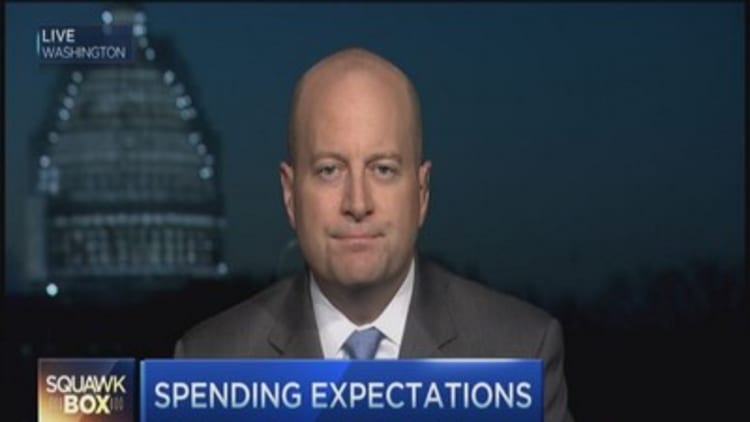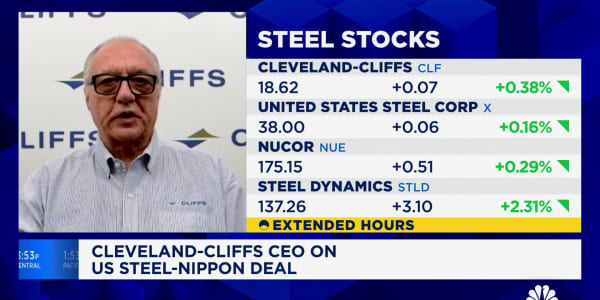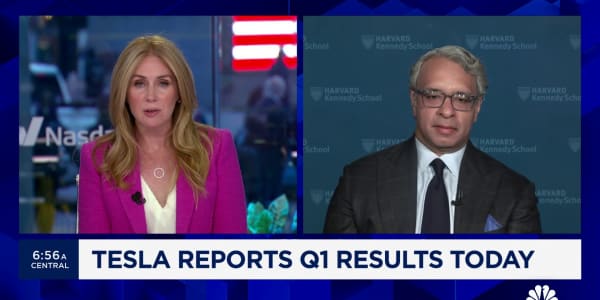2015 is shaping up as the year the U.S. consumer will have to shine the light for the rest of the world—or else.
Main Street Americans have been the neglected stepchild of the bifurcated post-crisis economy, in which stock market players at the top of the scale have seen their assets blossom while real incomes have stagnated and prices at the grocery store and gas pump climbed.
That dynamic at least has the potential to change.
Most strategists are predicting trend-like returns for the as they see less accommodative monetary policy creating a more challenging environment for equity gains.
Meanwhile, a strengthening dollar and declining energy prices are creating a more favorable landscape for consumers.
Michael Hartnett, chief investment strategist at Bank of America Merrill Lynch, believes the trend could be the most important thing for investors to watch in the year ahead:

We believe the plunge in oil price may, together with the recovery in the U.S. labor market, be the catalyst to reverse the massive post-Lehman outperformance of Wall Street versus Main Street. Overweighting assets related to the recovery on Main Street and under weighting assets tied to reflation of Wall Street in recent years has the potential to be The Trade of 2015.
Wall Street has done so well in large part due to the extreme benevolence of the Federal Reserve. The U.S. central bank has implemented three rounds of quantitative easing—a monthly bond-buying program that pushed the Fed balance sheet past the $4.5 trillion mark—and kept short-term interest rates near zero for the past six years.
Read MoreFed caused oil crash, stocks next: Peter Schiff
Taken in combination, the Fed's efforts have kept the liquidity valves open while allowing companies to borrow on the cheap—money corporate America has used to prop up share prices through share buybacks and dividends.
Fed advocates believe a cheap dollar helps large-cap companies that rely on cheap exports for revenue growth. Indeed, S&P 500 companies see 46.3 percent of their revenue come from overseas, according to Howard Silverblatt, senior index analyst at S&P Capital IQ.
The calculus changes, though, when looking at the broader picture. Just 13 percent, or $2.1 trillion, of the $16.2 trillion U.S. economy comes from exports. Conversely, about 68 percent, or just shy of $11 trillion, emanates from personal consumption expenditures i.e., the consumer.
Read MoreCheap oil: A win for airline passengers or stocks?
A stronger dollar helps consumers through increased purchasing power, and aids small businesses—the primary growth engine of U.S. job creation—who rely on domestic consumption for most of their revenues.
Hartnett thinks the best trade in the coming year, then, is to "sell Wall Street and buy Main Street":
No wonder stocks like Cracker Barrel and other "low-income retailers" are currently rising. We believe another Main Street versus Wall Street trade would be long regional banks versus Wall Street banks. Finally, some relief for even the European consumer may be at hand, and following a big bounce in global airline stocks, other consumer cyclicals appear to be doing better—even cyclical European auto stocks have outperformed in recent weeks.
The success of Hartnett's thesis will be critical. As global economies struggle and Russia fights its way through an existential financial crisis, investors will be looking for the U.S. to be an oasis in a turbulent environment.
Bob Janjuah, the often-bearish fixed income strategist at Nomura Securities, believes things could get ugly if the American consumer comes up short:
If I boil 2015 down to one thing, it will be the U.S. consumer—on the basis that the U.S. is the relative bright spot in the global economy. For 2015 to end up being a bullish year for risk assets with attractive Sharpe Ratios I think the U.S. consumer will have to deliver as I see no other obvious driver of global economic growth and inflation. There will need to be U.S. consumption growth of 4 percent to 5 percent if this bullish outcome is going to play out. This will require the U.S. consumer loading up on debt again. As of now, I rate this as only a slim possibility rather than a probability,
Household debt grew 2.7 percent in the third quarter to $13.4 trillion, according to the Fed. Business debt, with its low interest rates and comparatively easy access, has been far outpacing the growth of consumer leverage, with a 5.2 percent increase in the last quarter to $11.8 trillion.
Read MoreLew: Lower energy prices huge boost to economy
Should the U.S. fail to have strong enough economic coattails, the final resort would be a familiar one: Central bankers to the rescue.
The Fed ended its most recent round of easing—known on Wall Street as "QE3"—in October. But the very nature of the latest iteration was that the asset purchases were "open-ended," meaning that unlike its predecessors, which set a definite amount of purchases the Fed would target, this round came with no such restrictions. Only the recently introduced "data dependent" language in which the Open Market Committee said it wouldn't be handcuffed by the calendar or specific dollar amounts of purchases has put handcuffs on the extent to which the Fed will boost liquidity, even with the end of QE3.
Another faltering in the economy or financial markets could usher in what would effectively be QE4, according to Janjuah:
I realize that it is not normal to have a bearish risk view for December through to mid-January. Normally markets tend to ramp up in December and early January before selling off later in January. But this year I do think things are different. One look at the moves in core bond markets over 2014, when almost everyone I talked to had been bearish bonds, paints a stunning picture. I would entitle this picture 'The Victory of Deflation', or (as many folks now talk about (but still generally dismiss)) 'The Japanification of the World'. I may end up eating my words in 2015 if the U.S. consumer does come through, but if he or she does not, then we may well need QE4 from the Fed to battle the incredibly strong headwinds of deflation around the world.






